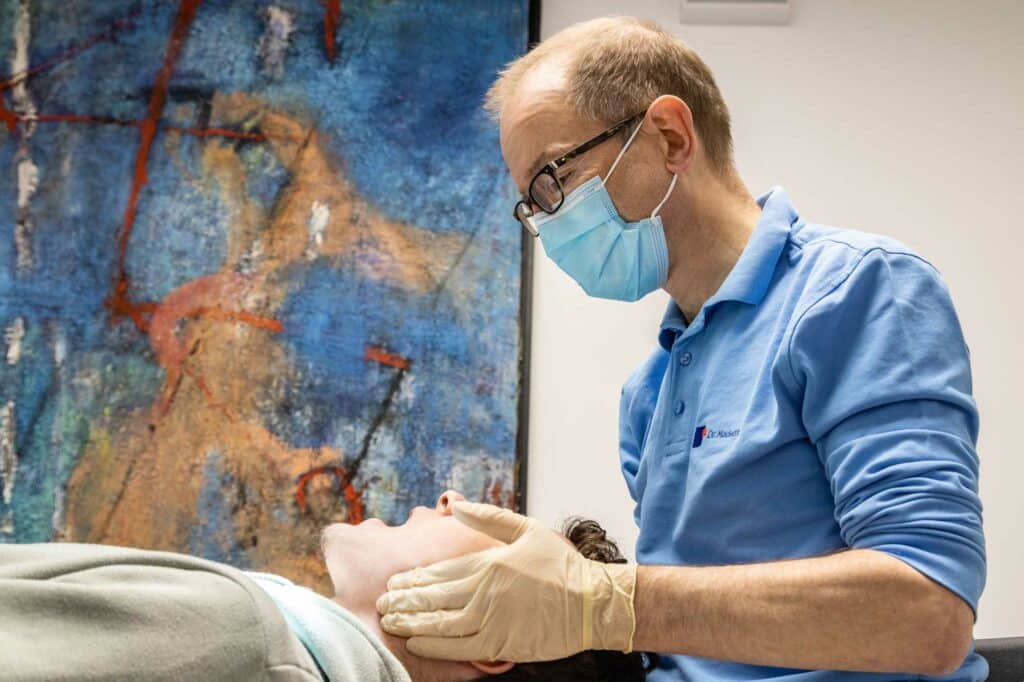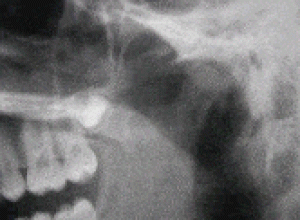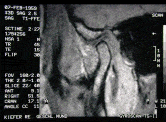Craniomandibular Dysfunction and Facial Pain
The term craniomandibular dysfunction (CMD) – also temporomandibular dysfunction (TMD) – describes painful disorders of the chewing muscles and the jaw joints. The term myoarthropathy (MAP) is commonly used in Switzerland. CMD is among the different forms of oral and facial pains the most common pain after toothaches. At one point in time, between 3 and 12 percent of the population suffer from CMD depending on the method of examination. Pain in the chewing muscles makes up about three quarters, whereas pain in the jaw joint only makes up one quarter. CMD is a comparable phenomenon to the even more common back pain. Both of them belong to the larger group of musculoskeletal pains.
Here is a short summary, while we have a dedicated website about CMD for more information: https://www.madsen.de/kiefergelenk-/
Causes
For many years dentists have believed that a bad bite was the main cause for CMD, but it is known today that teeth only play a subordinate role in causing the symptoms. In fact, CMD-patients do not show bite relations differentiating from those of healthy persons. Often, further examination does not detect organic causes for the symptoms, in particular no specific organ damages which could be healed or repaired. Female gender, age between 20 and 50 and various psychological stress factors are the main risk factors known for developing CMD symptoms.
Luckily, CMD are usually benign and self-limiting, meaning they normally disappear on their own and without treatment – just as the most forms of back pain. Often, patients repeatedly experience periods of pain from time to time. Constant pain develops rarely (chronification) and is mainly connected with psychological stress factors.
CMD Diagnostics
Diagnostics is based on a detailed medical history which mostly leads to a suspected diagnosis. After that, a physical examination consisting of a short dental functional analysis and some tests taken from manual medicine and the palpation of the outer chewing muscles follow. The examination is completed with a panoramic X-ray image. We largely follow the RDC/TMD or DC/TMD, which are a worldwide proven diagnostic scheme. These simple and cost-efficient measures lead to a reliable diagnosis in almost every case.

MRI of the Jaw Joints
In general, magnetic resonance imaging (MRI) of the jaw joints doesn’t make much sense, even though they show not only the bony structures but also the joint capsule, the ligaments and the discus. Of course, this is of great scientific interest. Unfortunately, the great hopes set on this technology were deceived since most of the irregularities found in the MRI are not related to pain experience at all. In fact, the temporomandibular joint is a rather patient structure, which can still function quite passably even with large changes in shape.
For this reason, the MRI does not have any therapeutic consequences but worries the patient unnecessarily. MRI is recommendable for patients suffering from heavy pain in the jaw joints which do not react to the usual therapy and before – rarely necessary – surgical interventions on the jaw joints. Unfortunately, MRI is still utilized out of ignorance or to impress the patient and feint expertise.


CMD Treatment
As CMD is usually self-limiting, it is all about helping the patient to turn the corner as fast as possible. The most important aspects of our treatment concept are consulting, information and instructions for self-help. Typical self-help measures include the targeted avoidance of unnecessary tooth contacts, relaxation exercises for the jaw muscles, stress management and general relaxation procedures such as the Jacobson progressive muscle relaxation (PMR).
For some cases, bite splints, manual therapy with specialized physiotherapists and medication are appropriate. A supplementary psychological pain therapy where patients learn how to handle pain and how to relax can be included.
In a few rare cases, referrals to other experts like otolaryngologists, orthopedists, neurologists, and experts in sleep medicine can be issued because problems of all fields listed above might be involved in causing pain.
Teeth and jaw misalignments are almost never the cause which is why neither orthodontic treatment nor procedures like reproducing dental prostheses or surgery are advisable. For this reason, severe chronic pain should not be treated utilizing such aggressive and irreversible procedures since they mostly cause more damage than benefit.
